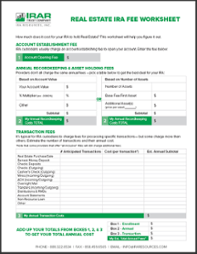The Secret to BIG Savings: Self-Directed IRA Fees Explained

As much as we all wish retirement plans were free of charge, they aren’t. Companies that provide services for retirement plans ALWAYS charge fees in some way, even if it’s not clear how. After all, they have to cover basic business costs to service your account, so they always find a way.
Even so, you’ll sometimes see promotions by big banks where they offer great benefits like making a contribution to your account or promises to match your retirement savings, all while promoting these accounts as free— don’t be fooled. There is no such thing as a free IRA.
Here is a limited list of fees you’ll find with most retirement accounts (not just self-directed IRAs):
- Inactivity fees
- Asset fees
- Low balance fees
- Commission fees
- Service fees
- Management fees
- Other fees
- Advisory fees
- Investment fees
- Participant fees
- Minimum account funding requirements to receive bonuses
This is an excerpt from IRAR's eBook, "Yes! You CAN Invest in Real Estate With Your IRA!"
Fees have a big impact on retirement savings— they slowly add up over time, preventing you from putting your hard-saved money to work for your future retirement. It’s been shown they’re one of the biggest drains on retirement savings, year after year. A difference of just 1% can make a huge difference over a lifetime, leaving you with less to save and invest for your future— and that’s true beyond just self-direction.
It’s pretty simple— the more you pay on fees, the less you have to save, invest, and grow for your future.
Because of this, it’s important to carefully compare costs between IRA custodians, so you know you’re not wasting money you meant to save for your retirement.
You can end up saving literally thousands of dollars when comparing costs across providers. We recently had a new client transfer their account to IRAR and they saved $1,700 on annual fees alone, because their old provider charged based on the total value of her account. It makes a major difference.
Use this chapter to help you do your research and compare costs across providers, so you know you’re getting the best deal for your self-directed IRA. Let IRAR help you get the best value for your real estate IRA.
Self-Directed IRA Custodial Fees: Explained
Most providers divide their fees into two categories: annual administration or recordkeeping fees and individual transaction fees. But every self-directed IRA provider is different and charges differently— some providers are all-inclusive, with others based on number or type of asset, some charge annually, while others charge quarterly. It’s a good idea to confirm the custodian’s fee schedule when opening the account, so you know what you’re paying up front.
Annual & Recordkeeping Fees
Annual administration/recordkeeping fees are the fees you pay your provider yearly for their administration and custody of your account.
Custodians have a few ways they charge annual administrative fees— most charge a percentage based on the total value of your account (not just the available cash), sometimes referred to as per-value. Some (like IRAR) charge a flat fee based on the number of assets, often called per-asset. Even fewer charge an all-inclusive fee that covers a limited number of transactions each year, but this is not common.
On top of these recordkeeping fees, per-value custodians sometimes charge an additional asset-holding fee. This is sometimes annual, semi-annual, or even quarterly (on top of other annual and transaction fees). Some providers do charge an asset fee for cash, or sometimes they’ll incorporate the cash into the overall value of the account.
The charge for holding real estate is often one of the most expensive, ranging from $20 to $600 per asset. Look out for other fees like this, since some custodians aren’t always transparent about how much their accounts can cost.
When talking about self-directed IRAs, per-value tends to be the most common way to charge. Note— this is usually calculated based on your overall account value, not just the cash in the account.
An Example…
The average IRA is worth about $100,000.
At one of the more expensive per-value IRA custodians, this average investor would pay about $550 (or $300 at the cheapest provider).
At a custodian that charges per-asset, this same investor would pay based on the number of assets. Say this real estate investor owns one single-family home in their IRA— at a per-asset custodian like IRAR, they’d pay our minimum fee of $199 a year.
If your account was worth more, you could be saving even more.
Another Example…
So say your IRA has a balance of $300,000, and holds 2 real estate assets.
At one of the more expensive per-value custodians, that puts you at $946 a year.
At a custodian that charges per-asset, you’d pay based on just the number of assets, no matter the value— for example, at a company like IRAR you’d pay $274 a year ($199 base asset fee + $75 additional asset fee).
That’s a savings of $672.
Keep that in mind— the way your provider charges can make a big difference in your annual IRA costs. Make sure their fee schedule makes sense for your investment strategy.

Want to see how much YOU could save?
Download the free eBook and get the Real Estate IRA Fee Worksheet
Transaction Fees
This is an area some IRA providers can really get you. Most custodians charge fees for processing various transactions on top of administrative fees. This is standard practice in the industry to cover basic business costs, but some companies are more eager to pass those fees along to you than others.
There are some fees you’ll run into almost everywhere (like check, wire, and overnight fees), but others are less common and you’ve got to watch out for them (like charging for earnest money deposits, statements, or non-recourse loans).
You won’t be able to avoid transaction fees entirely— even if using a provider touted as “all-inclusive”, there’s almost always a catch. If you take stock before you begin, you can find a custodian that doesn’t break your retirement bank before you even get there.
These little fees add up.
Costs to Purchase Real Estate with a Self-Directed IRA
There are a few things real estate investors tend to get charged for other investors don’t need to worry about. Most providers will charge for processing purchases and sales. Some have additional fees for Required Minimum Distributions and non-recourse loans, or if you’re transferring in real estate you already own from another plan. Almost all providers charge to send funds out of your account, as banks generally charge per-transaction, but the amount varies.
An example of savings:
Fees Associated with a Real Estate Purchase
(Not all fees apply to every purchase)
- Purchase (includes Non-Recourse Loan and Earnest Money Deposit) - $175
- Check - $7.00
- Cashier’s Check - $30.00
- Overnight Delivery - $30.00
- Wire Transfer - $30.00
- ACH Transfer - No Fee
- Notary Fee - $15
Some providers will also charge an additional fee to process HOA payments, utilities, and other bills, but not at IRAR. However, we do charge depending on the method of payment processing (shown in the above chart). You can save on these fees by researching custodian fees and prepaying these in bulk, or through a property manager that your IRA reimburses all at once.
In a Nutshell
If you want to invest with a self-directed IRA, you’ll have to pay someone to custody your retirement account (that part’s a requirement). But you don’t have to pay out the nose to do so— low-cost providers do exist, you just need to know what to consider for your strategy.
The key things to consider are:
- How they charge— per-value or per-asset, and how that impacts your account
- Transaction fees— do they charge for every little thing, and does it impact your savings plan?
- How frequently they charge— do they bill quarterly? Annually?
- The rest— that’s up to you.











Comments (0)